-
Car Reviews
- All reviews
- Midsize SUVs
- Small cars
- Utes
- Small SUVs
- Large SUVs
- Large cars
- Sports SUVs
- Sports cars
- Vans
Latest reviews
- Car News
-
Car Comparisons
Latest comparisons
- Chasing Deals
The new Kia Stonic small SUV has landed in Australia – but how do the more affordable variants stack up in the real world?
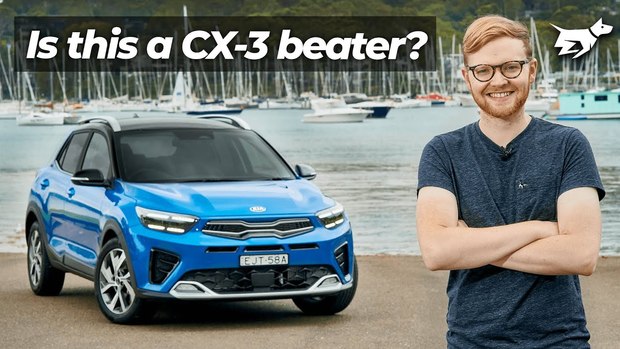
For some time, Kia has been kicking goals in the Australian SUV market, with gold stars like the Sorento seven-seater and small but spacious Seltos achieving a rare mix of critical acclaim and sales charts successes. However, the ‘light’ SUV space has been without a Kia competitor – until the launch of the new Stonic earlier this year.
In reality, the Stonic is already four years old overseas, and has recently been taken off-market in Korea due to slow sales performance. However, in Australia, the Stonic is just about the most affordable vehicle in its market segment, save perhaps for the distantly related Hyundai Venue.
The Stonic starts from as little as $22,990 driveaway for the S base model, but we’re testing the mid-range Sport here with an automatic gearbox.
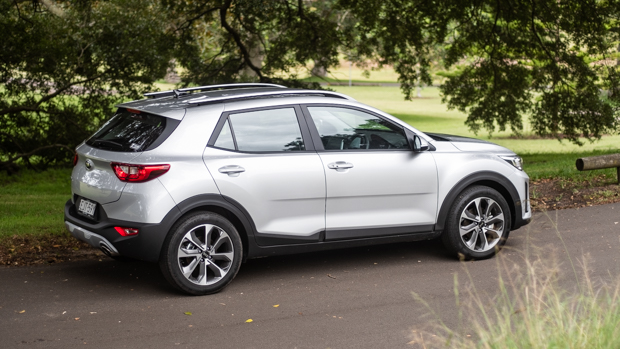
On paper, the mid-tier Sport offers everything you need and nothing you don’t, which makes the $25,990 driveaway price of the Stonic Sport seem pretty reasonable on the face of it.
Competitors for the Stonic are generally priced around 10 per cent higher; they include the new Toyota Yaris Cross, Skoda Kamiq and long-term favourite Mazda CX-3. So, the Kia Stonic Sport may offer an outstanding price, but dollar amounts are by no means everything.
In editor Baker’s review of the flagship Stonic GT-Line ($29,990 driveaway), it was pointed out that the Stonic is really little more than a pumped-up Kia Rio hatchback with some cladding. The Stonic shares the Rio’s two engines, platform, and controversially, its 2017 five-star ANCAP safety rating.
Powering the range-topping GT-Line is a fairly punchy turbocharged one-litre three-cylinder petrol engine that makes 74kW of power and 177Nm of torque coupled to a seven-speed DCT gearbox. All Stonic grades drive the front wheels exclusively.
Our Sport and the $23,990 base model S have the more humble powertrain of the Stonic lineup: a naturally aspirated 1.4-litre four-cylinder engine with 74kW of power and a lowly 133Nm of torque.
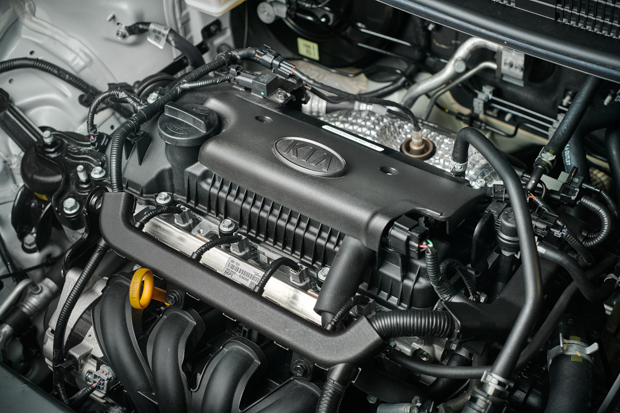
The meagre outputs are only half the story: it’s also about where this engine makes (or doesn’t make) its torque, which arrives asthmatically late at 4,000rpm – and then you still have to push through a headache-inducing four-cylinder groan to get to 6,000rpm, where peak power finally crashes the party.
Pair those conditions to a slow-witted six-speed automatic gearbox that slurs away from traffic lights and jerks on downshifts, and you’re left with a noisy, unrefined package.
It’s a shame that there is no sport mode for the drivetrain, as that low-power 1.4-litre motor is really hampered by the gearbox constantly shifting back to a tall gear mid-corner. You can select ratios yourself in manual mode, but the Stonic is reluctant to downshift in practice.
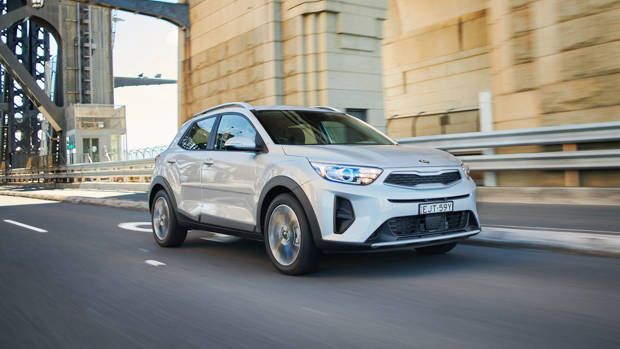
While it hasn’t arrived in Australia yet, Kia will offer a six-speed manual transmission for $1,000 less. If you can drive a manual, we would suggest buying one as the extra control will negate some of the engine’s poor traits when combined with the dull six-speed auto.
Or, if you can stretch to the circa-thirty grand Stonic GT-Line with standard auto, you should: it’s a far lower-effort car to drive.
Luckily, the bones of the Stonic aren’t bad. The Sport gets a less aggressive suspension tune than the GT-Line but shares that car’s 17-inch alloy wheels shod in quality 205/55 series Continental rubber.
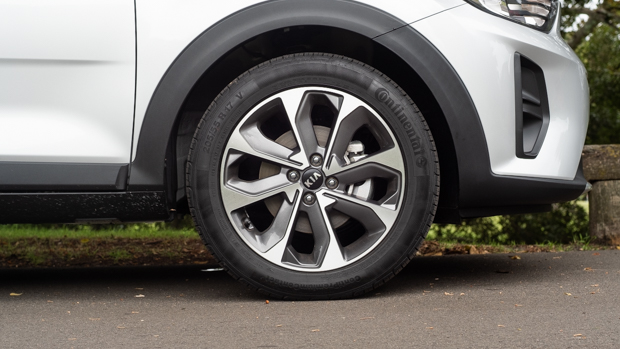
There is a terseness to the Stonic’s low-speed ride that plagues many small SUVs. We found that hitting speed humps and expansion joints faster than usual made for a smoother urban ride, but the Toyota Yaris Cross is still a more relaxed car in an urban environment.
Take the Stonic out of the city, and things improve – clearly, the suspension was tuned for country roads first and foremost. The firm low-speed ride gives way to a calm one at highway speeds. NVH suppression is impressive for the class, but you won’t mistake the Stonic for a luxury vehicle.
The Stonic further impresses down twisting roads by resisting excess body roll and offering the driver remarkable adjustment mid-corner like a well-tuned hatchback might. The torsion beam rear end is not sophisticated, but the chassis does feel poised and steadfast on a technical road.
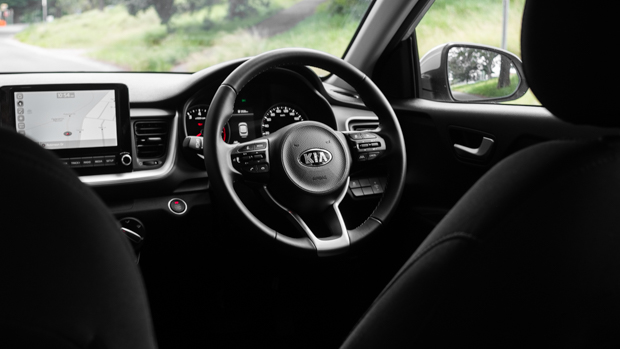
The steering rack is not the quickest out there, but the Australian programming the Stonic has gone through resulted in really good steering weighting.
Being so heavily based on a conventional hatchback, the Stonic offers good rear and side visibility in the class with minimal bulky pillars to peer around. The size also made for easy parking in tight city streets.
Where the Stonic falls down against its peers is in the safety department. Sure, it has a five-star ANCAP rating – but this is not a five star rating based on today’s demanding standards. Instead, it is an outdated 2017 five star score carried over from the Rio. As such, no Stonic grades are available with junction or reverse AEB functionality or adaptive cruise control.
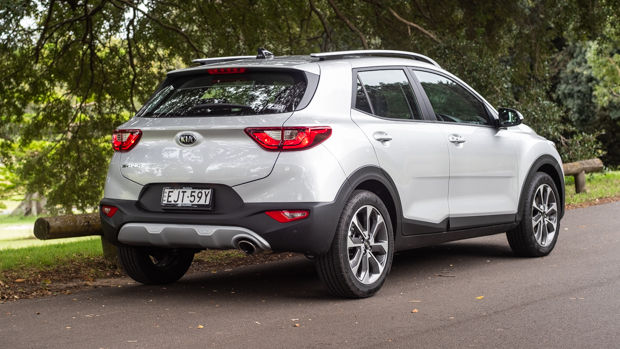
The Toyota Yaris Cross, which scores a five star rating based on ANCAP’s much more demanding current protocol, has many more safety features fitted as standard.
All Australian Stonics are, however, have AEB with pedestrian and cyclist detection fitted, lane-trace assist, a rear-view camera and rear parking sensors.
Mediocre engine and gearbox aside, the Kia Stonic does have plenty of kerb appeal. Rugged black-plastic cladding extends from the sills around the wheel arches, which hide a chunky set of 17-inch alloy wheels.
One detail you may miss but is worth appreciating are the roof rails which, on our Silky Silver (a $520 option) car, look particularly good. Almost like the roof’s metal has been cleaved out and pulled up, rather swanky.
Inside the Stonic, it all steps backwards, certainly when it comes to touchpoints. Most surfaces are covered in scratchy plastic; the dash, the doors, the centre console are finished in what feels like brittle freeze-dried rubber. But the Stonic is a cheap car, after all, and the dearer Volkswagen T-Cross doesn’t have hugely elevated cabin material quality either.
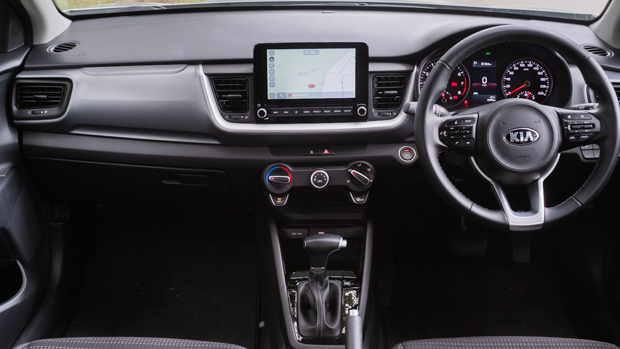
Thankfully, the high-traffic touchpoints in the Stonic are pleasant, with a leather-appointed steering wheel that feels great in the hand, and a 50s-esque leather automatic shifter. The cabin design is platonic in the Sport – the GT-Line gets chintzed up with faux-carbon trimmings and alloy pedals.
Technology levels are respectable, with a crisp eight-inch touchscreen on the dashboard that runs wired Apple CarPlay and Android Auto. Navigation and DAB are standard too, which is a nice touch at this end of the market.
Dials are analogue, but a 4.2-inch TFT screen gives all the information needed in the Stonic.
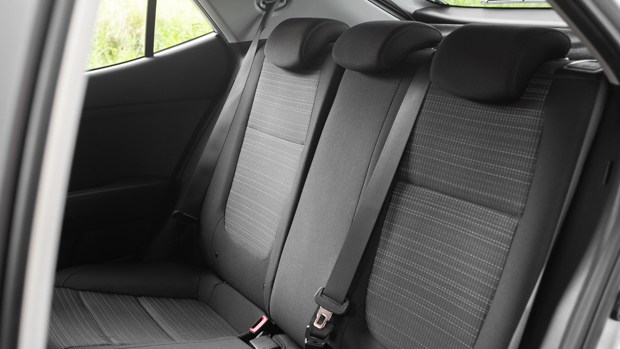
Practicality is another strong point for the Stonic with generous door bins that offer space for big bottles, two cup holders next to the manual handbrake and dual-level storage that works well for smartphones.
The pews are cloth-appointed, manually adjustable, relatively comfortable, and set low in the Stonic – a nod to its humble Rio underpinnings. That suits me at six-foot-two, but those looking for the high-and-mighty SUV driving position will be better served elsewhere.
Rear seat passengers will be comfortable, too, with ample headroom, reasonable toe and legroom. Unfortunately, there is no centre armrest or air vents, but one USB port brings the Stonic’s total count to two.
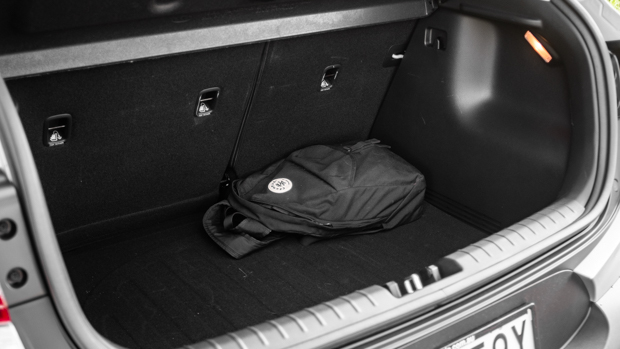
The boot is ample for the class, offering 352 litres of space – blitzing a Mazda CX-3’s small cargo area – but there aren’t many clever features in the back of the Kia.
There is a cargo hook tacked onto the bottom of the parcel shelf – we would avoid hanging anything heavy from that. There is also a space-saver spare beneath the boot floor.
We predict that ownership of the Kia Stonic Sport will likely be fairly trouble-free, given its simple mechanicals and Kia’s seven year, unlimited kilometre warranty that is up there with the very best guarantees in the Australian market.
However, the capped price servicing programme offered with the Stonic is not the cheapest out there. Servicing the 1.4-litre Stonic will cost $2,103 over five years, with services costing $281, $467, $336, $702, and $317 over that period.
The costs aren’t outlandish, but servicing this car’s main rival, a Toyota Yaris Cross, is more consistently affordable throughout its lifespan.
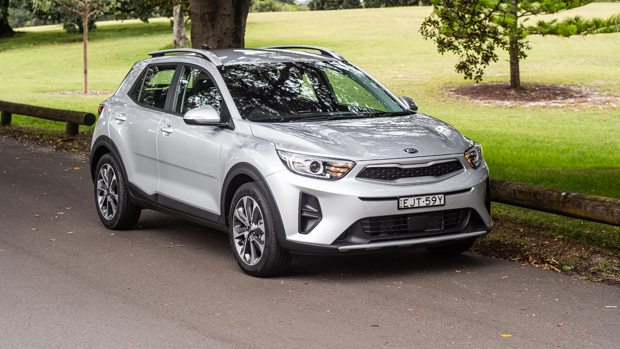
Fuel consumption was simply average. The 1.4-litre multi-point injection motor was remarkably thirsty around town. We saw 9.5L/100km running around town, with that figure dropping to 7.5L/100km out of the city.
Again, not terrible figures but they are numbers that fall short of Kia’s 6.7L/100km claimed combined figure.
To us, the poor consumption indicates this 1.4-litre motor is over-stressed in the Stonic during real-world driving, and Kia would be better off with the larger 1.6-litre engine found in the Hyundai Venue.
It’s also noteworthy that the turbocharged Stonic GT-Line achieves slightly better economy despite feeling much quicker.
The Kia Stonic SUV looks good and delivers on the claims of great practicality and good technology features for the price. Engine notwithstanding, this car’s biggest problem is the Rio which, in equivalent Sport trim, is $3,000 less.
Most Australian buyers will be able to find a Rio hatch equipped with the vastly superior one-litre turbo engine for the same price as this Stonic Sport, which makes this tiny SUV seem like poor value.
Of course, the Stonic’s appearance will make it much more appealing in the showroom than the Rio.
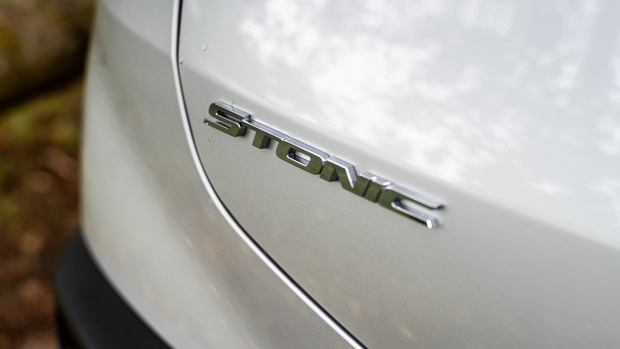
When put up against direct competitors like a Mazda CX-3 and Volkswagen T-Cross, the Stonic’s price tag looks much more reasonable, and it does offer a lot of quality technology.
The Stonic’s dynamic poise is impressive, because it drives much like a hatchback.
In a world where light SUVs are everything, the Stonic is affordable and has a place; just make sure you test drive both engine options before you put any money down.
Variant tested SPORT
Key specs (as tested)
About Chasing cars
Chasing Cars reviews are 100% independent.
Because we are powered by Budget Direct Insurance, we don’t receive advertising or sales revenue from car manufacturers.
We’re truly independent – giving you Australia’s best car reviews.
The estimate provided does not take into account your personal circumstances but is intended to give a general indication of the cost of insurance, in order to obtain a complete quote, please visit www.budgetdirect.com.au. Estimate includes 15%^ online discount.
^Conditions Apply
Budget Direct Insurance arranged by Auto & General Services Pty Ltd ACN 003 617 909(AGS) AFSL 241 411, for and on behalf of the insurer, Auto & General Insurance Company Limited(ABN 42 111 586 353, AFSL 285 571).Because we don’t know your financial needs, we can’t advise you if this insurance will suit you. You should consider your needs and the Product Disclosure Statement before making a decision to buy insurance. Terms and conditions apply.
Indicative quote based on assumptions including postcode , 40 year old male with no offences, licence suspensions or claims in the last 5 years, a NCD Rating 1 and no younger drivers listed. White car, driven up to 10,000kms a year, unfinanced, with no modifications, factory options and/or non-standard accessories, private use only and garaged at night.
^Online Discounts Terms & Conditions
1. Discounts apply to the premium paid for a new Budget Direct Gold Comprehensive Car Insurance, Third Party Property Only or Third Party Property, Fire & Theft Insurance policy initiated online on or after 29 March 2017. Discounts do not apply to optional Roadside Assistance.
2. Discounts do not apply to any renewal offer of insurance.
3. Discounts only apply to the insurance portion of the premium. Discounts are applied before government charges, taxes, levies and fees, including instalment processing fees (as applicable). The full extent of discounts may therefore be impacted.
4. We reserve the right to change the offer without notice.